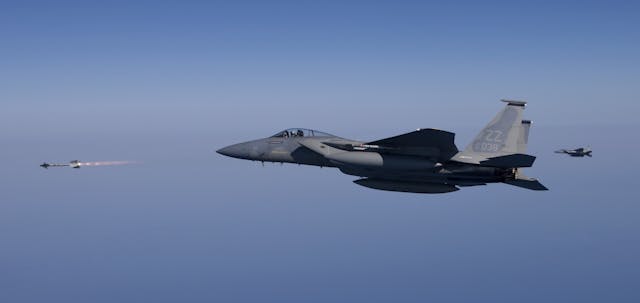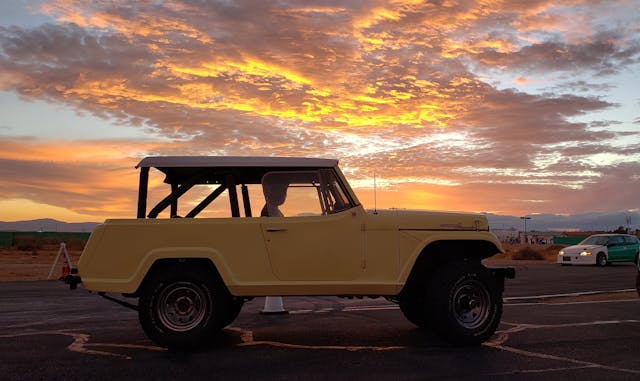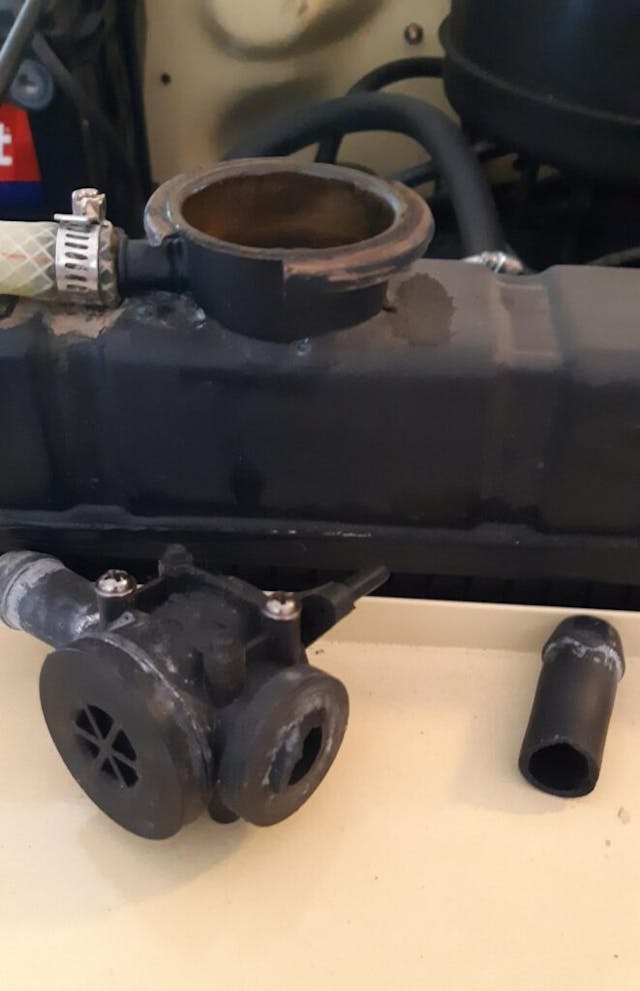Fighter Pilot Diaries: Tactical Emergencies
So there I was, flying on my commander’s wing, heading into enemy territory. We expected to encounter a robust presence of enemy fighters, but they didn’t materialize. Successfully avoiding the Surface-to-Air Missile (SAM) threat, we arrived at the target area, dropped our bombs, and turned towards home.
Coming off target, where the focus has been on air-to-ground work, a high priority is always to sanitize the airspace in front of you for enemy fighters. After just a couple of sweeps of my radar, two “hot” contacts appeared on my scope, heading right for us. As I quickly started the process to determine if they were friend or foe, my commander radioed to inform me that his jet had been damaged by enemy fire as we came off target. He was able to slowly limp along, but he was defenseless: He had neither a functioning radar nor use of his weapons.
The contacts on my radar continued bearing down on us. I declared them hostile and waited for the opportune time to shoot missiles at them. My jet carried enough to eliminate the threats, but with my now-wingman unable to employ his weapons, the margin for error was minimal. All the while I worked to maneuver the formation to protect my commander from the incoming threat while still ensuring that I maintained the ability to shoot first.

I took a deep breath to clear my mind and focus on solving the complicated tactical puzzle in front of me. I could feel the pressure building. The geometry of the aerial intercept dictated it was time to shoot, but at that moment something exploded in my cockpit. The sounds of a stampeding herd of elephants filled my ears. Had I been hit, too? It took a few precious moments to realize the compressor that maintains my cockpit pressure had shelled itself and, now in its death throes, was loudly squealing its protestations.
As I was flying around 25,000 feet, I needed to rapidly descend thousands of feet due to the loss of cabin pressure. With a crippled wingman needing my protection, my own aircraft falling apart, and enemy aircraft bearing down on us, I made the only sensible choice: I called a Knock It Off (KIO) to terminate the exercise.
The exercise was my final exam, known as a checkride, to prove I was ready to gain my initial combat qualification in a fighter aircraft. Having to stop the checkride early was frustrating, because I didn’t know if I had done enough to pass. I descended to a lower altitude, and my commander escorted me and my fighter—which was actually crippled, unlike his jet, which had suffered only simulated damage—back to base.

As we debriefed the mission and talked through the actions I would have taken to protect my commander while negating the air threat, he mentioned I had experienced the ultimate tactical emergency: nothing too serious, but serious enough to warrant immediate action and a KIO. Fortunately, I had handled myself well enough during the mission to earn the coveted combat qualification, and the cool leather jacket that comes with said qualification, stampeding elephants notwithstanding. (When we watched my cockpit tape, the sound was loud enough to be heard over the wind and jet noise.)
Over my ensuing flight hours, which number in the thousands, I have experienced several emergencies, though none as perfectly timed as that one. While I’ve dealt with a few failures multiple times (electrical malfunctions, minor engine issues, etc.), I never again had that pressure turbine fail.
That said, my 1969 Jeepster Commando has tried to kill me at least three times. Somehow, each incident arrived at the perfect moment, or the failure occurred in such a way, to ensure that I didn’t actually die and that no part of me was bruised or injured, other than my ego.

The Jeepster’s first attempted murder occurred on my initial drive after fighting an electrical gremlin for a couple months. Unable to find where I had shorted a wire—that much was evident, since the same fuse blew every time I energized that particular circuit—I hired a car electrician recommended to me by a buddy who built and drove race cars. The electrician proceeded to find and fix the short in less than 30 minutes. (I’m no stranger to self-inflicted automotive issues.) Wanting to drive the Jeepster the 40 minutes to work the next day and knowing it had sat for a while, I decided a quick test drive was in order.
At a stop sign two miles from the house, having slowed to a stop from the 55-mph speed limit, completely content with how she handled and ready to take her to work in the morning, I made a 90-degree left turn back towards home. When I turned the steering wheel to the right to complete the turn, the wheels stayed pointing left and started to pull me into the oncoming lane. I turned the steering wheel harder, pushed down and pulled up on it, thinking the steering wheel had become loose from the steering shaft, and eventually spun it like I was on an automotive version of The Wheel of Fortune, all to no avail. Fortunately, the road was deserted and had wide shoulders. I coasted to a stop in the dirt, popped the hood, and saw a nut on the coupler holding the upper and lower steering shafts had come loose.
So overconfident had I been that my test drive would go well I hadn’t brought any tools with me; I couldn’t sufficiently retighten that stupid nut so as to be confident it wouldn’t come loose again. I called my incredible, and incredibly patient, wife, who answered, “Well, that didn’t take long!” She brought me the needed tools and I drove home, though I opted not to drive to work until I could thoroughly look over the Jeepster. If I had lost steering one minute earlier while cruising at 55 mph … Needless to say, that coupler now has lock nuts on it and I frequently check them before heading out for a drive.
A couple years later, I had an incident with the Jeepster that caused me to wonder which would be preferable: no steering or no brakes. Would you rather have zero control over what you hit (no steering), or be able to choose what you hit (no brakes)?
Pulling into my driveway after my 25-minute drive home, most of which was on the freeway, I came to a stop on my driveway and waited for the garage door to open so I could pull in and park. As I applied the brakes, I heard a loud PSSSSHHHHH sound from the passenger side of the car. Hopping out to see what was up, I noticed a growing puddle of brake fluid on the ground by the right front tire.
Long story short, when I rebuilt the Jeepster, I had apparently bought front brake lines that were just a bit too long. Over the intervening years, the brake lines rubbed against the tires during turns and the hose in question finally failed in my driveway, the wear in the hose from the tire clearly evident. Again, if the line had failed a few minutes earlier while I was on the freeway, I doubt the ending of the story would have been so benign.

Last summer I drove the Jeep to work on a beautiful, sunny morning. Windows were down and a giant smile was on my face as I cruised the 20 minutes—about half on the freeway and half either on surface streets or on base—to work. Per my usual habits, I watched the temperature and oil-pressure gauges more closely than I do in my newer vehicles, and everything looked great. About half a mile from my parking space I passed through the final checkpoint and accelerated to the 20-mph speed limit (speeding on base is definitely not recommended!). As I shifted from first gear to second, I suddenly found myself in a sauna. Steam billowed everywhere. I heard the sound of rushing water and tasted the distinct flavor of ethylene glycol.
Looking towards the front passenger seat whence emanated the bubbling noises, I spied green radiator fluid gushing forth from a heater hose. Fortunately, I could see through the glycol gloom and didn’t drive off the road or run into something or someone. Additionally, the Jeepster has holes in the floor—not rust holes, but actual drain holes—so the coolant just ran out of the Jeep onto the road. Finally, I was close enough to work that I could essentially coast to my parking spot (not that there was anywhere to park along the way), so I did just that. The couple times I blipped the throttle to maintain my momentum increased the flow of radiator fluid from the hose, unsurprisingly—all the more reason to coast, but water was still trickling out as I entered the parking lot. The temp gauge had, thankfully, remained steady.
Finally at my spot, I shut off the car and exhaled. Licking my lips, I tasted more ethylene glycol and realized that I, and everything else in the passenger compartment, was covered in a fine layer of atomized radiator fluid. Fortunately, I had set my backpack holding my laptop on top of the passenger seat and not on the floor, or it would have immediately been soaked through. Even more so, I’m grateful my wife or a child wasn’t in the Jeepster, or that the spray wasn’t directed at me or my face, and thus only the passenger-seat mount was doused with 200-degree fluid. I sat there, collecting my thoughts, and watched the fluid slowly drain from the passenger floorplan, the sounds of the coolant splattering on the ground growing quieter. (In)conveniently, my wife was out of town so she wouldn’t be able to rescue me again; I’d have to ask a coworker to drive me home, where I’d collect both a tow vehicle and tow bar—a version of the taxi of shame, but at least I wouldn’t have to call a tow truck.
After I got the Jeepster home, I discovered a broken fitting on a line to/from the heater core. I presume my routing of hoses put some torque on the fitting and roughly a decade later, it decided it was out. The fitting rolled inverted, stripped to the waist, and ejected, leaving me shell-shocked by the suddenness of its failure.

As a hobbyist mechanic, at best, I am painfully aware of the limitations of my knowledge and ability. However, it’s not these known unknowns that really scare me; it’s the dreaded unknown unknowns, to paraphrase then–Secretary of Defense Donald Rumsfeld (and others). The mistakes I don’t know I’m making that could lead to a suboptimal outcome are the things that really worry me about working on my cars. Those fears aren’t enough to preclude me from doing crazy things, like undertaking a frame-off restoration in my garage, but I try to be as informed as is reasonably possible of the work I’m doing so as to eliminate the unknown unknowns.
Still, when the car’s proverbial rubber meets the road, or when an airplane’s wings fall under Bernoulli’s spell, sometimes it’s nothing more than a well-timed tactical emergency that makes the difference between a funny story with a benign ending and a challenging real-world emergency.
I’ve had lots of people over the years ask me if I’m interested in building my own airplane. They know I’m a pilot and that I like to work on cars, so they see it as a natural marriage of those two skills (though saying I have mechanic-level skills is being generous, at best). I have several friends who have successfully done so, and one who is currently building an airplane in his garage, but my answer is always a firm, unequivocal, and immediate no! In fact, I couldn’t possibly be more out on the idea of building my own airplane. After all, I’ve struggled at times to keep the Jeepster running and I rebuilt that essentially all on my own in my garage. Yet having something fail on the Jeepster would be, in all likelihood, way less serious than if a similar failure were to occur in the air on a plane I built. There’s no calling a KIO when a wing falls off the airplane you built—and are flying! That’s not a tactical emergency at all. I’d spend the entire time from wing falling off to ground impact wishing I’d used locknuts.
***
Check out the Hagerty Media homepage so you don’t miss a single story, or better yet, bookmark it. To get our best stories delivered right to your inbox, subscribe to our newsletters.



I have an old, old friend who was a chopper pilot in Vietnam. He became a private pilot afterward and has built several planes of his own (one in his garage!) and frequently flies his wife to local mountain towns for brunch. I’ve watched him work on some of his projects and am always amazed at his attention to detail and thoroughness. I’ve never broached the subject of an aircraft failure with him, as I think he’d be extremely insulted. But I have wondered more than once if he or his wife have contemplated falling from the sky over forested mountains some weekend morning.
But really, I’ve built several project cars from the frame up, and I’ve taken my wife, my children, and my grandchildren in them at highway speeds. I’ve even taken loved ones in rigs I built up rugged mountains when one wrong move might throw us hundreds of feet into a ravine. Did I contemplate something failing and putting out lives in danger whenever setting out on those excursions? Not really. I had to be confident that what I’d done was correct and safe. Overconfident? Also not really. I regularly service and inspect all of the critical areas of my builds to ensure there are no cracks in welds, no loosening bolts, no worn brake lines, etc.
I think we all need to realize that dangers are everywhere, and that we need to be vigilant – but – if we just live in fear that “something might go wrong at a bad time”, we’ll never enjoy much in life (and we’ll darned-sure never get any fighter pilots)!
Agreed on all counts and I tip my hat to your chopper buddy!
Josh, another great read and as someone once said: Man’s got to know his limitations. Glad you know yours and are not building an SR-71 in the garage….
SR-71 in the garage would be awesome.
You’re gonna need a much bigger garage, buddy!
I watch these skateboarders and dirt bike riders pull some amazing stunts, and I realize that they adopted those skills by taking some hard lumps combined with a certain amount of good fortune that those lumps weren’t life-changing. Tempting fate isn’t for the weak of heart but it does have some value as a learning tool.
Great article, Josh! I get your angst about the DIY work on our vehicles. My kids call my vehicles “crap cars” because I always had old ones that someone either gave to me or I acquired on the cheap….. thus they always required work…. that I did…. some of which came unglued at the most inopportune moments.
But, that doesn’t negate the joy we experience driving something that runs because we worked on it!
Thanks for the fun read!
steve
I am a pilot who is building a kit airplane. I am also a mechanic, although not an aircraft mechanic. If built without deviating from the plans, most amateur-built aircraft are as safe as factory-built ones, most of which are aging. I have flown a plans-built airplane for many years without incident. Having said all that, I recently lost a pilot friend who WAS an aircraft mechanic and was trying out a new propeller. It lost a blade on takeoff and caused a lethal crash. I respect your decision not to build your own airplane but hope that you understand that with attention to detail and proper inspections along the way, an amateur-built airplane can be as safe as any other.
I’m sorry to hear about your friend’s death. I have a few friends who’ve slipped the surly bonds in crashes, military and civilian, so I know what you’re going through.
I caught a flight just a couple weeks ago in my buddy’s home-built RV-7 and it was a beautifully flying aircraft. I tip my hat to you and those who build and fly such machines!
Another great story. Glad the situation in the plane was thankfully simulated.
Same! I’ve had some interesting moments in combat, but nothing quite to that extreme.
Reading “I’ve had some interesting moments in combat” makes me want to comment that we owe HUGE thank yous to Josh and all his fellow military pilots, past, present, and future!
Out of the three events, I’ve experienced – or been experience-adjacent – to two. In 1977, my future wife owned a ‘73 Datsun 610; Datsun had made the wonderful engineering decision to route the heater line through the passenger footwell. One afternoon I got a phone call from her saying something had exploded in her car. Fortunately, she had been approaching a stop sign and was nearly stopped when the line ruptured, spewing coolant all over the cabin. She was able to bail out without injury.
Two years ago, I took our Jaguar for a repair at a local shop. The owner called me asking if I’d had a recent brake job. “Yes, about a year ago, in another town.” He told me that the person who did the work was sloppy about routing the brake line, and it had been rubbing against the CV boot, wearing both. The boot was worn through, and had lost all its grease. The brake line was nearly so, and in imminent risk of failure. Bullet dodged, but a pricey fix!
Glad your results were similar to mine: survivable!
Once drove my M38A1 Jeep over train tracks whilst trailing a johnboat to an early AM meetup with some speckled perch. Dropped the pitman arm bolt and scared the S out of my young nephew in the passenger seat. “Look Ma! No steering!” He failed to get the reference and was not amused. We found the bolt and reinstalled same using some rad hose and a worm clamp. Worked fine.
Glad neither of you were injured and I thought it’s awesome that you found the bolt, reinstalled it, and continued on your way! Hope the fish were biting!
I was in the Marine Corps in the ’70s and drove an Austin Healey 100-4. One day we had a uniform inspection and I wore a fresh set of crisp khakis. While driving onto the base, I felt something warm on my left leg. When I parked and got out of the car my left pants leg was completely soaked in used black motor oil, The cable drive tachometer was pumping oil out from under the dash. Needless to say , I got out of the inspection…That time.
That’s funny. I didn’t have inspection the day my heater hose blew, but other than a smell of ethylene glycol, my uniform looked alright.
And I hope the 100-4 drove as nicely as it looked!
Your articles never fail to entertain and inform, Josh. It’s also wonderful that you read and often respond to comments. I’ve been saying for decades steering is vastly more important than brakes. You can usually coast quite a ways without contacting any obstacles but the edge of the road and the oncoming lane are often mere inches away. My wildest example is the day I was towing my dad’s crap can with my aged sling truck (“frugality” runs in the family) and I lost all brakes on a downhill. With the old man in the passenger seat I kept my composure while carrying on small talk and silently plotted the best way to arrive at my driveway with the least speed. Couldn’t have done it without steering, and too ashamed to ever brag to him about it.
There’s a similar story of Scott Crossfield losing his brakes (self-inflicted) after landing and taxiing his aircraft into a hangar, and punching the nose of the jet through the hangar wall. Good job not doing that! And if your dad didn’t notice at all you did a very nice job.
Thanks for reading and I’m glad you enjoy my articles!
My 62 GMC pickup blew out the front brake line but not in my driveway. I just started down a mountain pass here in Colorado with a big load of firewood. I tapped the brakes and the pedal went to the floor. I had the added bonus that the hydraulic clutch shared the master cylinder reservoir so the clutch was gone too! I made some very deliberate down shifts with that old 4 speed and I’m surprised that big V6 didn’t explode but using the hand emergency brake under the dash about a mile later it was parked on the shoulder of the highway. Aren’t old vehicles wonderful?
That’s a great story and you handled the situation very well!
And then there are the times when they actively try and kill you….
I had a 1984 grey-market Range Rover I rebuilt (extensive corrosion) that decided to jam its accelerator full-on when coming out of a traffic light in my home town on a Saturday morning in heavy traffic. I would not have minded finding a tree or a power pole to stop it so much if my then-10-year-old daughter had not been aboard.
Thankfully, I managed to reach down and cut the ignition into the magic zone on the lock cylinder that turned off the engine electricals but did not lock the steering. I then managed to maneuver it (sans power steering) to an empty spot at the curb in the town centre and brake it to a halt – narrowly missing the parked car ahead of us as the brake boost faded.
Turned out a worn throttle cable had snapped a strand or two which jammed against the housing inside lip, holding the EFI in WOT position and unfortunately accelerating the freshly-rebuilt V8.
After that little performance I did myself a favour and sold the car on. I’ve owned many Land-Rover products since, but never one as malicious as that one.